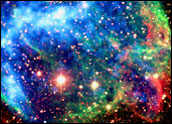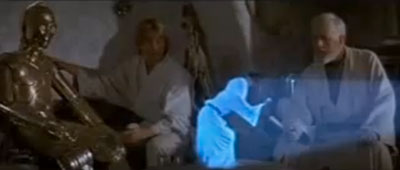
It’s difficult enough for most humans to grasp the idea that our planet is just one of countless others in our galaxy — and a pretty small one, at that.
Then, of course, there’s the concept that our galaxy is just one of billions of others in the universe — sure to compound any confusion considerably.
It seems safe to say, however, that neither of those notions can compete on the mind-bending scale, so to speak, with an idea that’s currently being investigated at the U.S. Department of Energy’s Fermilab.
Ready for a hurting brain? Here goes: Fermilab is working on a device to test the theory that our whole universe is simply a hologram.
‘Help Me, Obi-Wan Kenobi’

Holograms are probably at least somewhat familiar to most, if no other reason then for the role they occasionally play on the silver screen. Princess Leia’s entreaty in the “Star Wars” series, for example, may well be one of the most memorable examples in cinematic history.
Holograms are also commonplace today on CDs, DVDs and credit cards.
Strictly speaking though, holograms are just diffraction patterns. Essentially, they’re what you get when you record the light scattered from an object and then later reconstruct that light, giving the appearance of a 3D object even when the object is no longer there.
From Energy to Matter and Back Again
Back to the universe: There’s been a theory kicking around for several decades now suggesting that the universe itself may be a hologram.
The 1982 book by Ken Wilber, Holographic Paradigm, for example, tells of the way psychologist Karl Pribram and physicist David Bohm both arrived at the notion of a “holographic universe” in which things that appear to be solid are not necessarily so, Paul Czysz, a professor emeritus of aerospace engineering with St. Louis University, told TechNewsWorld.
Pribram, the psychologist, had noted the way “an abstract thing like a picture that you see with your eyes is translated into a molecule in your brain,” Czysz explained. “When that molecule is later activated by your memory, you see the picture again. It’s an abstract thing locked into a physical entity that can repeat the picture.”
Bohm, meanwhile, focused on “how energy can transform itself into matter,” he added, drawing on Einstein’s famous equation.
Both, in other words, were interested in situations where “things we think are solid may not be,” Czysz noted. “Instead, they may be a projection of something — it’s not physical, and yet in the next instant it is.”
A decade after the publication of Wilber’s book, author Michael Talbot went on to publish a similar one entitled The Holographic Universe.
‘Smaller Than the Point of a Pin’
Adding to the compelling nature of such theories is the fact that the vast majority of what we see as solid objects is actually empty space.
“An atom is essentially a point with a cloud of electrons,” Czysz noted. “If you took a human and removed all the space between the electrons and nucleus of each atom in his or her body and then condensed it down, the human would be smaller than the point of a pin.”
In other words, each of us — like a hologram — is “basically a diffraction pattern that appears to be solid,” he suggested. Solid as we may feel, we’re mostly just empty space.
How’s that for mind-bending?
Even beyond the bounds of our planet, with all the stars and galaxies out there, it’s estimated that we can only perceive about 5 percent; the rest — the majority — is made up of dark energy and dark matter.
“The reason we don’t see the rest of it is that we don’t have access to that part of the hologram,” Czysz said.
A Year’s Worth of Energy
Then, too, there’s the interchangeability of mass and energy, as Einstein so famously explained.
“Only in our minds are they separate entities,” Czysz pointed out.
Each and every one of us, in fact, is essentially a vast amount of energy condensed into physical form, he noted.
“If there were a way to transform you into your energy base, the ball of energy that would come out of where you are would be equivalent to what a metropolitan power station would generate over about a year,” Czysz asserted.
If we are mostly just empty space and energy, then — despite our solid appearance — why shouldn’t the universe be similarly holographic, in other words?
A Cosmic ‘Jitter’
The study of black holes has already led to the suggestion that our 3D reality is simply a holographic projection of what exists in two dimensions in the very outer edges of the universe. Generally referred to as the “Holographic Principle,” that idea combines the work of Gerard ‘t Hooft, Charles Thorn and string theorist Leonard Susskind.
Interest in the concept of a holographic universe was revived most recently, however, when Craig Hogan, a professor in the department of astronomy and astrophysics at the University of Chicago and director of the Fermilab Center for Particle Astrophysics, launched a project to create an instrument that can help scientists better understand any holographic properties of the universe.
Drawing upon the Holographic Principle, the premise behind the Fermilab project is that space is two dimensional, and that the third dimension is inextricably linked with time. If that’s the case, our 3D world is merely an approximate illusion.
Assuming that’s true, the illusion is likely imperfect and blurry, just as photographs and videos are, especially when viewed on a granular level. Such imperfection would introduce “a particular kind of noise or jitter into spacetime, as measured by the propagation of light in different directions,” the Fermilab explains.
By building an instrument — called a “Holometer” — to detect that cosmic “jitter,” Hogan’s team hopes to find evidence of a holographic universe.
Building a ‘Holometer’
“The basic idea is to measure directly whether the fabric of space and time itself shares some of the same quantum uncertainty that we know exists in wave/particles like atoms and photons,” Hogan told TechNewsWorld. “Maybe all of reality has a limited amount of streaming information, like a download at the Planck frequency of 10^44 bits per second. If so, we can measure the sampling noise from that.”
Such a measurement “would help us understand how matter, energy, space and time work at the most basic level,” he added.
Some prototype tests of the Holometer have already been completed, Hogan said, “but it will be about a year before the Holometer is built, and probably another year of commissioning and debugging after that before we get a result at the theoretical sensitivity.”
‘We Are Starting to Get Tantalizing Results’
There’s at least one encouraging precedent.
“Historically, we have had already a situation where something manifesting itself as ‘noise’ turned out to be a huge discovery,” Mario Livio, a senior astrophysicist with the Space Telescope Science Institute, told TechNewsWorld.
Specifically, such a detection was what led to the discovery of the cosmic microwave background, Livio explained.
It remains to be seen, of course, whether the Holometer will produce equally exciting results.
“I am somewhat skeptical about the implications for the holographic universe idea, but the good news is that new experimental tests are being proposed,” Livio said. “These could perhaps take us one step closer to understanding the nature of this noise.”
What is “truly encouraging,” meanwhile, “is that we are starting to get tantalizing results from gravitational wave detectors, from the FERMI Gamma-Ray Space Telescope, and even from the Hubble Space Telescope, which appear to be starting to probe the very fabric of spacetime,” Livio pointed out.
The European Space Agency, in fact, just recently announced results from its Integral gamma-ray observatory that could cause many theorists to revise their thinking.
Different Approaches, Similar Implications
In any case, the idea of a holographic universe can be approached and thought about in multiple ways. It’s potentially holographic in a sense by virtue of the fact that the solid objects around us are mostly just empty space, and that their mass is essentially just condensed energy.
The world only appears solid, in other words.
Viewed through the lens of space scientists, meanwhile, its potentially holographic nature derives from fundamental properties of the fabric of space and time.
That two such apparently divergent approaches both suggest such a possibility, however, makes it all the more compelling.
Is the world we know and love just an illusion in the grand scheme of things? It seems a distinct possibility. Will that change the way we live our lives? Almost certainly not.
There’s no denying, however, that it can be a lot of fun to think about.






















































Is this really a revelation? Haven’t we known for quite some time that we are mostly empty space?
As a Buddhist, I find it AM using that science is confirming what the Buddha taught–that life is an illusion. Physics confirms the precepts of Buddhism.